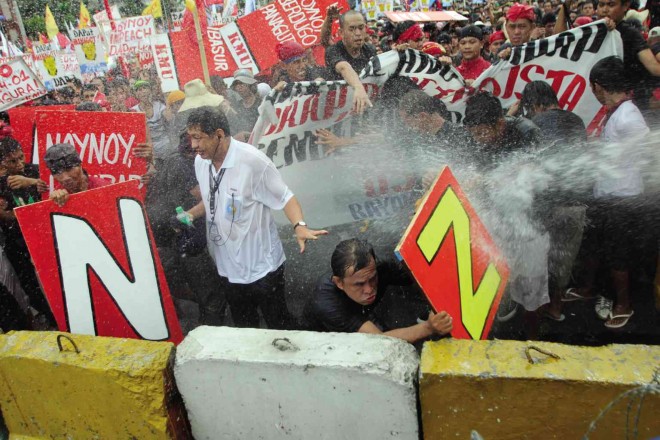
WATCHDOG WASHED DOWN Commission on Human Rights Director Gilbert Boiser (in white shirt, with ID) finds himself at the receiving end of a water cannon spray together with Sona protesters in Quezon City on Monday. REM ZAMORA
MANILA, Philippines–For the Commission on Human Rights (CHR), the use of water cannons to turn back protesters during President Aquino’s delivery of his fifth State of the Nation Address (Sona) on Monday violated UN standards and was not necessary for a “very manageable” mass action.
The commission on Tuesday said it would seek an explanation from police officials in charge of crowd control for the Sona. The inquiry, the first in years to focus on the use of water cannons against protest marchers, could make law enforcers think twice about the tactic, which the CHR said is “permissible only in the event of widespread public disorder.”
“Our position is that the use of water cannons violates the ‘necessity and proportionality’ principles of the UN standards on the use of force during law enforcement operations,” according to CHR spokesman Marc Titus Cebreros.
The Sona rally in Quezon City, Cebreros noted, was “self-contained and very manageable” and did not warrant the use of water cannons.
The investigation could give rise to administrative and criminal cases—for grave misconduct or physical injuries—being filed against liable police officials, he said.
Red-tinted water
Authorities used four fire trucks to repulse protesters with jets of red-tinted water as the latter tried to break through layers of security barricades composed of concrete barriers, steel fences, concertina wires, freight containers and phalanxes of antiriot personnel.
Among those drenched in the dispersal on Commonwealth Avenue was CHR Director Gilbert Boiser, who was monitoring the rally.
Meanwhile, Kilusang Mayo Uno chair Elmer Labog recalled that the police also sprayed tinted water on protesters during the Marcos dictatorship and that the use of water cannons on Monday was an “overkill.”
“It hurts because of the strong water pressure,” Labog said in a press conference. “We were just protesting and airing the real state of the nation.”
Rights experts agree
Cebreros explained: “Regarding the legality of using water cannons, human rights experts agree that it is permissible only in the event of widespread public disorder where law enforcement operations would be actually hampered without their use.”
He cited as an example the 2011 London riots, which left five people dead and scores of policemen and civilians wounded in clashes erupting across the city.
Cebreros also recalled how the Philippine government filed a protest after a Chinese vessel hosed down a boat of Filipino fishermen on the disputed Panatag Shoal in January.
“US Ambassador Philip Goldberg agreed that the use of water cannons is not justifiable and is illegal. We should be consistent in the application of human rights policing standards,” the CHR spokesman stressed.
‘Calibrated, preemptive response’
National Capital Region Police Office chief Director Carmelo Valmoria, who oversaw the implementation of the Sona security plan, defended the use of water cannons, saying it was a “calibrated, preemptive response.”
“Without that, things may have gotten worse and led to physical contact between the antiriot policemen and protesters. More people would be hurt,” Valmoria said.
The NCRPO chief pointed out that for the first time in many years, no one from both sides went home injured from a Sona protest rally. “No one was hurt, so in our point of view it was a successful operation. We just hope that they also respect the human rights of our policemen on the frontline.”
Security measures relating to Sona rallies were directly handled by Senior Supt. Procopio Lipana of the Quezon City Police District, who reports to QCPD director Chief Supt. Richard Albano.–With a report from Jaymee T. Gamil